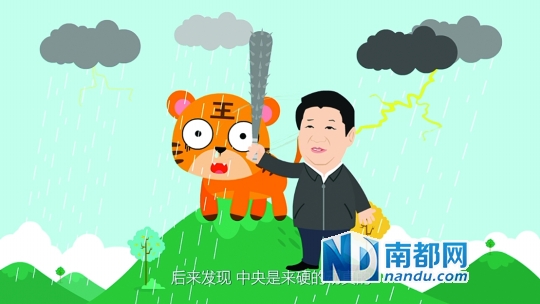Animated image of Xi Jinping again a hit online
(Xinhua) Updated: 2015-02-20 16:53
|
 |
|
The animated image of Chinese President Xi Jinping wielding a stick to hit a tiger is a hot topic online these days. [Photo/nandu.com] |
BEIJING - Three online animations themed around China's anti-corruption campaign and featuring President Xi Jinping have been a hit over the Spring Festival, with netizens delighting to what is apparently a relaxing of attitudes to depicting Chinese leaders by cartoon.
The animations, each about two minutes long, compare the situation before and after the 'Mass Line' campaign, the 2013-2014 initiative aimed at strengthening ties between CPC officials and the public.
They are entitled "Is the 'Mass Line' Campaign for Real?", "Is It Easier for the Public to Get Stuff Done with the Government?" and "Are Officials Really Scared?"
|
 |
|
The animated image of Chinese President Xi Jinping eating and talking with a family. [Photo/nandu.com] |
The cartoon Xi eats and talks with members of the public, waves a flag bearing the characters of "Mass Line campaign", and wields a stick to hit a tiger, a reference to his targeting of high-ranking corrupt officials.
The videos were uploaded to popular Chinese video streaming website Youku on Tuesday night and were picked up by other major video websites as well as social media forums Weibo and WeChat the following day. They have been viewed hundreds of thousands of times.
As with October 2013 animation "How Do They Become State Leaders?", which was the first to feature Chinese leaders, the producer is mysterious.
The clips are credited to the unknown producer "Chaoyang Studio" and no other information is provided. "How Do They Become State Leaders?" was credited to "On the Road to Revival Studio".
An Internet user with the screen name "Glory and Dream" said that "we see in the clips the CPC central committee's determination to fight corruption".
Some netizens called for the swatting of "flies", referring to lower-ranking corrupt officials.
Observers have speculated that the cartoons are designed to break the conventional mystery surrounding Chinese leaders and publicize government policies in a more attractive, easily-digestible way.
- Govt encourages people to work 4.5 days a week
- Action to be taken as HIV cases among students rise
- Debate grows over reproductive rights
- Country's first bishop ordained in 3 years
- China builds Tibetan Buddhism academy in Chengdu
- Authorities require reporting of HIV infections at schools
- Typhoon Soudelor kills 14 in East China
- Police crack down on overseas gambling site
- Debate over death penalty for child traffickers goes on
- Beijing to tighten mail security for war anniversary







